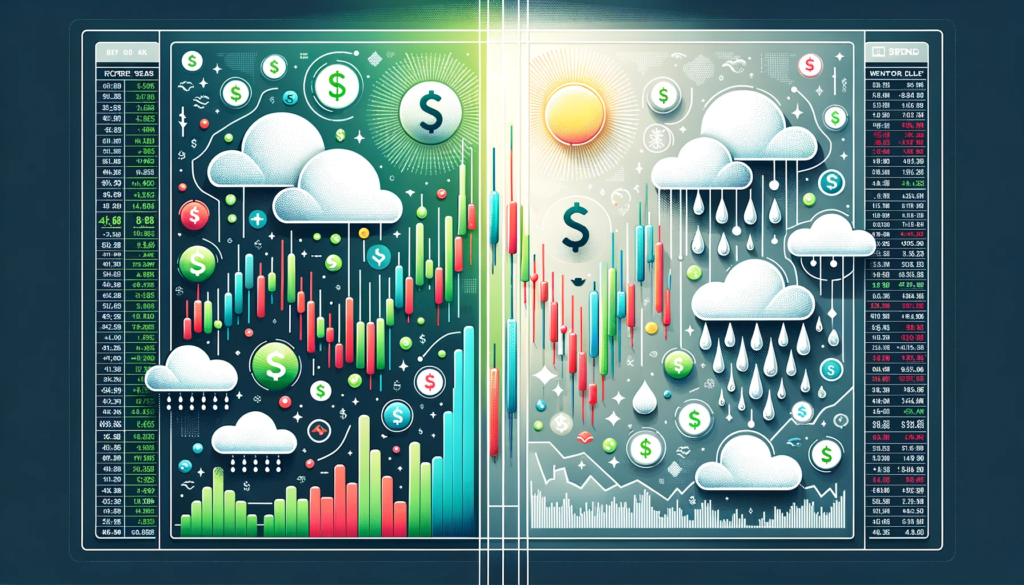Introduction to Weather Derivatives
Weather derivatives are financial instruments utilized to hedge against unexpected weather conditions that can potentially impact businesses. These instruments take the form of a contract between a buyer and a seller, where the seller agrees to assume the risk of a weather event in exchange for a premium. On the other hand, the buyer expects to receive payment if the specified event occurs or loses the premium if nothing happens.


These derivatives are traded over-the-counter (OTC), through brokers, and via an exchange. They can take the form of swaps, futures, or options. However, unlike regular financial derivatives, weather derivatives have an underlying weather parameter, such as temperature, rainfall, or daily sunlight. This means that the underlying cannot be directly traded like an option, limiting certain strategies like delta hedging. The non-tradeable nature of weather parameters also impacts the pricing mechanisms of weather derivatives. The absence of a direct trading market leads to reliance on historical weather data and sophisticated meteorological and statistical models to price these derivatives, adding complexity to their valuation (pricing challenges). The market for weather derivatives is therefore considered incomplete.
Here are a few examples of the weather parameters that can be traded in weather derivatives:
- Temperature:
- Cooling Degree Days (CDDs)
- Heating Degree Days (HDDs)
- Energy Degree Days
- Rainfall:
- Critical Rainy Days
- Successive Rainy Days
- Sunlight:
- Critical Sunny Days
- Successive Sunny Days
- Snowfall:
- Critical Snowy Days
It’s worth noting that around 95% of all weather derivative contracts are based on Heating/Cooling Degree Days (HDD or CDD).
Rationale Behind Using Weather Derivatives
The profitability and revenues of various industries, including agriculture, energy, entertainment, construction, travel, and more, significantly depend on the effects of temperature, rainfall, and storms. Unfortunately, unexpected weather conditions rarely result in price adjustments that fully compensate for lost revenue. This makes weather derivatives a crucial investment for many companies, as they provide a means to hedge against adverse weather events that can impact their business.
Different sectors have different reasons for utilizing weather derivatives:
- Companies dependent on weather conditions, such as hydroelectric businesses and sports event organizers, incorporate weather derivatives into their risk management strategies.
- Farmers use weather derivatives to hedge against poor harvests caused by excessive or insufficient rainfall, sudden temperature fluctuations, or destructive winds.
How Weather Derivatives Work
Weather derivatives were introduced in the mid-1990s as over-the-counter (OTC) products primarily traded between two individual parties. These contracts were conditional clauses, where one party would offer a rebate if a specified weather condition occurred. As weather derivatives gained popularity, they became tradable futures, options, swaps, and options on futures contracts on exchanges.
- The Chicago Mercantile Exchange (CME) offers weather derivatives specific to locations, such as US cities like Des Moines or Las Vegas, and global cities in Europe and Asia, focusing on temperature-specific products.
- Weather derivatives measure the variation of temperature from the monthly or seasonal average in a designated city or region. These variations are then converted into dollar-weighted indexes, allowing for a quantified dollar value for temperature fluctuations.
- Contracts are typically linked to heating degree days (HDD) and cooling degree days (CDD), which are based on a set temperature threshold of 65°F (18°C) in the US and Europe. HDD and CDD represent the amount of heating or cooling resources needed. For example, if the temperature goes below the threshold to 35°F, indicating a heating requirement, the HDD value would be 30, and the CDD value would be zero. On the other hand, if the temperature goes above the threshold to 85°F, indicating no heating requirement but a cooling need, the HDD value would be zero, and the CDD value would be 20.
- The value of each contract is calculated by multiplying the HDD or CDD value by $20 for each day or month. For instance, if the HDD value is 30 and the CDD value is zero, the HDD contract value would be $600. Conversely, if the HDD value is zero and the CDD value is 20, the CDD contract value would be $400.
Understanding this mechanism allows individuals to strategically take hedge, arbitrage, or speculative positions.
Market Size & Evolution
Over the years, the weather derivatives market has experienced growth and evolution. In 2004, the notional value of CME weather derivatives was $2.2 billion, growing tenfold to $22 billion by September 2005. The OTC market was more active than the exchange, resulting in larger bid-ask spreads.
According to the annual survey by the Weather Risk Management Association, the estimated notional value of weather derivatives – including OTC and exchange-traded instruments – traded in 2008/2009 was $15 billion, compared to $32 billion the previous year and $45 billion in 2005–2006. However, despite the decline in overall contract numbers, the weather derivatives market continued to develop, expanding geographically and broadening its reach across industries.
Fast forward to today, the Chicago Mercantile Exchange reported a significant increase in weather futures and options open interest, with the average open interest four times higher in the January to September (2023) compared to a year earlier, and 12 times higher compared to 2019. In 2023, average open interest in CME weather futures and options contracts in September was around 170,000 contracts. Despite this growth, the weather derivatives market remains relatively small compared to commodity-linked derivatives.
Comparison with Traditional Insurance
While weather derivatives share some similarities with insurance, there are key differences between the two.
- Insurance primarily covers low-probability catastrophic events, such as hurricanes, earthquakes, and tornadoes. On the other hand, weather derivatives focus on higher-probability events, like a drier-than-expected summer.
- Insurance does not protect against reduced demand resulting from slightly different weather patterns, such as a slightly wetter summer. Weather derivatives can provide coverage for such fluctuations. As a result, some companies may have an interest in purchasing both insurance and weather derivatives.
- Conventional insurance contracts require demonstrating a loss before receiving payment. In contrast, weather derivatives pay out regardless of the actual impact on a company. Settlement is generally faster, and there is no traditional loss-adjustment process.
- Weather derivatives can be designed to correlate with the magnitude of adverse weather phenomena, offering more nuanced risk coverage.
- Weather derivatives are index-based, ensuring transparency in valuation.
Real-world Applications
Weather derivatives serve a variety of purposes across different industries. Here are some real-world applications:
- Energy companies can enter into weather derivatives to eliminate risks of varying temperatures leading to uncertain demand and supply for their power, utility, and energy business.
- By utilizing weather derivatives, energy companies can mitigate the financial risks associated with fluctuations in temperature, ensuring a stable supply and demand for their products.
- Farming businesses can get into derivatives contracts to eliminate the risk of poor crop production due to bad weather.
- These contracts include cases for heavy rains, low rains, adverse temperature conditions, or impacts of high winds or snowfall, allowing farming businesses to safeguard their operations and revenue against unfavorable weather conditions.
- Event management organizations, such as sports organizing companies, tour and travel companies, or open-air theme parks, can hedge against the negative impacts of rain on their event business.
- By utilizing weather derivatives, event management organizations can protect their investments and revenue from adverse weather conditions, ensuring successful and profitable events.
- Insurance companies, hedge funds, and governments also trade in weather derivatives for hedging purposes.
- These entities use weather derivatives as a risk management tool to mitigate potential financial losses caused by unpredictable weather events.
- Speculators, arbitrageurs, and market makers are attracted to weather derivatives for speculative betting or arbitrage opportunities on weather conditions.
- Speculators and market participants engage in weather derivatives trading to capitalize on price fluctuations resulting from weather forecasts and anomalies.
Agriculture, energy, and power companies are among the major players in the weather derivatives market, recognizing the importance of managing weather-related risks.
Impact of Climate Change
Climate change is significantly affecting the dynamics of weather patterns, thus influencing the weather derivatives market. The increasing unpredictability of weather due to global warming has intensified the demand for financial instruments that allow businesses to hedge against weather-related risks. Climate anomalies such as heatwaves, cold snaps, hurricanes, and prolonged drought periods have made the valuation and pricing of weather derivatives more complex.
The unpredictability introduced by climate change can lead to higher volatility in the weather derivatives market. Businesses, particularly in sectors like agriculture, energy, and tourism, find themselves more exposed to weather risks and thus have a greater need for risk management tools like weather derivatives.
Future Outlook
The future of the weather derivatives market is likely to be characterized by innovation and adaptation to the new challenges brought about by climate change. Technological advancements, such as improved weather forecasting models and artificial intelligence, could enhance the precision and reliability of weather derivatives.
Furthermore, the market may witness diversification in the types of weather risks covered and industries served. As awareness of climate change risks becomes more mainstream, a broader spectrum of businesses might seek to utilize weather derivatives as a tool for financial risk management.
The ongoing developments in global sustainability initiatives and green finance could also intersect with the evolution of the weather derivatives market, potentially influencing investment strategies and market participation.
In Asia, weather derivatives are slowly gaining attention. Countries like India, which are susceptible to weather-related events, have called for the introduction of weather derivatives to help reduce the impact on the economy. Additionally, China’s Guangdong Provincial Government has announced plans to explore the potential of weather futures in collaboration with the Guangdong Futures Exchange. However, Southeast Asian countries generally still lag behind in the use of weather derivatives.
Without a doubt, weather derivatives are vital for managing climate risks and protecting against the financial impact of severe and unpredictable weather events. As the effects of climate change become more pronounced, their relevance will only grow. Business as usual will no longer suffice.


